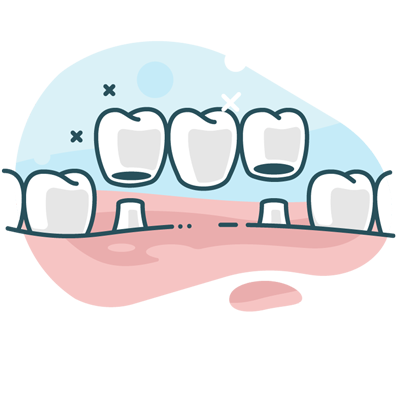Crowns & Bridges in Stoke and Nelson
 Dental crowns are custom-shaped restorations for your tooth. At Fresh Dental, we recommend crowns when large fillings have weakened a tooth, the tooth has broken down, and for cosmetic reasons.
Dental crowns are custom-shaped restorations for your tooth. At Fresh Dental, we recommend crowns when large fillings have weakened a tooth, the tooth has broken down, and for cosmetic reasons.
A good option for patients with severe damage to the tooth, a crown restores the structure and strength of your tooth, and improves your facial and smile aesthetics. Crowns minimise the possibility of decay by sealing the tooth from the rest of the mouth.
Your dentist may recommend crowns if you have any of these conditions:
- Yellow or discoloured teeth
- A loose, cracked or chipped tooth
- Unable to chew food comfortably or your bite is not aligned properly
- Had a root canal
Lost your teeth to periodontal disease or a traumatic injury
What to Expect
Creating your crown requires two visits over 2-3 weeks. The first appointment consists of the consultation and preparation of the tooth. X-rays are taken to determine if the tooth is a good candidate for a crown. If there is any extensive decay or risk of infection to the tooth, your dentist has to treat that first.
The tooth structure is shaped under local anaesthetic, creating a cone shape the crown will be cemented over. If there is very little tooth structure remaining, the tooth may need to be built up for the bonding to be successful.
Next, an impression is taken of the shaped tooth structure and sent to the laboratory to create your custom-made tooth. We also record your tooth colour to match with the new crown. You have a choice of materials for your crown, porcelain or composite. We recommend porcelain crowns for ease of colour match, durability, and stain resistance.
Since it typically takes 2-3 weeks for the crown to be made, we place a temporary crown over the tooth. When the crown comes back from the lab, the temporary one is removed, and the permanent crown is cemented into place. Your bite will be checked and adjusted if necessary.
 A dental bridge replaces missing teeth with false teeth. It is attached to the healthy teeth on either side of the gap. Bridges are usually made of porcelain or metal, or a mixture of both, and are fixed in place. Cantilever bridges are also an option. These are attached on only one end of the bridge, and require a crown to be placed on the unattached side.
A dental bridge replaces missing teeth with false teeth. It is attached to the healthy teeth on either side of the gap. Bridges are usually made of porcelain or metal, or a mixture of both, and are fixed in place. Cantilever bridges are also an option. These are attached on only one end of the bridge, and require a crown to be placed on the unattached side.
A bridge is used to increase function and have a better ability to chew. Aesthetically, it’s a good option for patients who don’t like having missing teeth or don’t want to use dentures.
What to Expect
After X-rays and examination, your dentist will prepare the teeth on either side of the bridge. A mold is made for the bridge, and sent to the lab. When your permanent bridge returns from the lab, it is put in place, and cemented to the prepared teeth.
After you receive your bridge, brush with fluoride toothpaste and floss, as is usually recommended for natural teeth. Regular visits to your dentist are also important.
Start Smiling Again
Call us today to discuss how a new crown or bridge can give you back your smile.
CONTACT US

